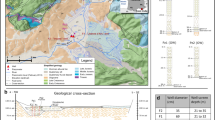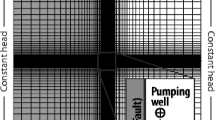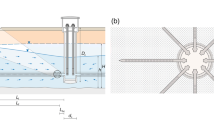Abstract
A digital radial (r-z-t) finite-difference model for the simulation of constant-discharge pumping-tests in multilayered ground is described. The model is particularly useful for the interpretation of multiport piezometer data since the drawdown at each port can be independently simulated on the r-z-t grid. Unlike conventional methods of pumping-test interpretation, where flow and ground properties are usually averaged over one or two layers, the radial (r-z-t) model allows a detailed approximation of the vertical variation in ground hydraulic properties.
A case study is described in which the radial (r-z-t) model is applied to the interpretation of multiport piezometer data from two pumping-tests carried out in a site investigation for a proposed new surface drift. The resulting permeability distribution is then used as input data to model inflows to the proposed drift under construction. Three-dimensional inflows to a short length of unlined drift open section are approximated using steady-state radial (r-z) flow models. Use of the numerical modelling techniques result in a better understanding of the groundwater system than that obtained from conventional analytical techniques.
Similar content being viewed by others
References
Bear, J., 1972. Dynamics of Fluids in Porous Media. Elsevier, New York, 764 pp.
Cooper, H.H., and Jacob, C.E., 1946. A generalised graphical method for evaluating formation constants and summarising well field history. Trans. Am. Geophys. Un., 27, 526–534.
Edwards, M.G., 1987. Mathematical modelling of groundwater inflows to shafts and drifts under construction. PhD thesis, University of Birmingham, August 1987, 508 pp.
Gambolati, G., 1976. Transient free surface flow to a well: an analysis of theoretical solutions. Wat. Resour. Res., 12 (1): 27–39.
Guvanasen, V., and Volker, R.E., 1980. Numerical solutions for unsteady flow in unconfined aquifers. Int. J. Numer. Meth. Eng., 15: 1643–1657.
Kruseman, G.P. and de Ridder, N.A., 1970. Analysis and Evaluation of Pumping Test Data. Int Inst I and Reclamation and Improvement Wageningen, The Netherlands
Lloyd, J.W., and Edwards, M.G., 1988. Estimation of groundwater inflow to an underground mining operation. Int. J. Mine Water, 7 (3): 611–623.
Rushton, K.R., and Redshaw, S.C., 1979. Seepage and Groundwater Flow. Wiley, Chichester, 339 pp.
Singh, R., 1976. Prediction of mound geometry under recharge basins. Wat. Resour. Res. 12 (4): 775–780.
Stone, H.L., 1968. Iterative solution of implicit approximations of multidimensional partial differential equations. Soc. Ind. Appl. Math. J. Numer. Anal., 5: 530–558.
Author information
Authors and Affiliations
Rights and permissions
About this article
Cite this article
Edwards, M.G., Lloyd, J.W. Pumping test data interpretation and drift inflow assessment by finite-difference radial modelling. Mine Water and the Environment 11, 15–34 (1992). https://doi.org/10.1007/BF02919579
Issue Date:
DOI: https://doi.org/10.1007/BF02919579




